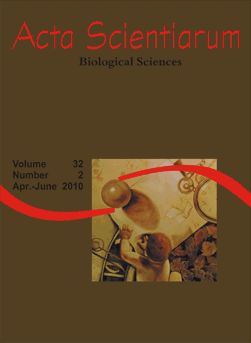<b>Padrões espaciais da riqueza de espécies de viperídeos na América do Sul: temperatura ambiental vs. cinética-bioquímica</b> - doi: 10.4025/actascibiolsci.v32i2.4303
Resumo
Este estudo tem por objetivo testar a influência da temperatura na taxa metabólica de viperídeos como um mecanismo básico de origem dos padrões espaciais de riqueza desse grupo na América do Sul, como proposto por Allen et al. (2002) dentro da Teoria Metabólica em Ecologia. Para isso, testamos a relação entre o logaritmo natural da riqueza de espécies de viperídeos e o inverso da temperatura (em Kelvin, 1000*K-1), após corrigir os efeitos da autocorrelação espacial, e verificamos se a reta estimada apresenta inclinação de -9,0*T. As variáveis apresentaram baixo índice de correlação (r2 = 0,216; p < 0,0001), com uma inclinação da reta de -3,737*T (C.I. (95%) ± 0,379). Os resultados indicaram que os viperídeos não respondem à variação de temperatura da mesma forma que os demais grupos testados, uma vez que o intervalo de confiança para o ângulo da reta estimada não contempla o valor -9,0*T, como predito pelo modelo. O presente estudo sugere que o padrão espacial da riqueza de espécies de viperídeos na América do Sul é estruturado por outros parâmetros além da temperatura, não contemplados no modelo de Allen et al. (2002).Downloads
DECLARAÇÃO DE ORIGINALIDADE E DIREITOS AUTORAIS
Declaro que o presente artigo é original, não tendo sido submetido à publicação em qualquer outro periódico nacional ou internacional, quer seja em parte ou em sua totalidade.
Os direitos autorais pertencem exclusivamente aos autores. Os direitos de licenciamento utilizados pelo periódico é a licença Creative Commons Attribution 4.0 (CC BY 4.0): são permitidos o compartilhamento (cópia e distribuição do material em qualqer meio ou formato) e adaptação (remix, transformação e criação de material a partir do conteúdo assim licenciado para quaisquer fins, inclusive comerciais.
Recomenda-se a leitura desse link para maiores informações sobre o tema: fornecimento de créditos e referências de forma correta, entre outros detalhes cruciais para uso adequado do material licenciado.












1.png)




3.png)













